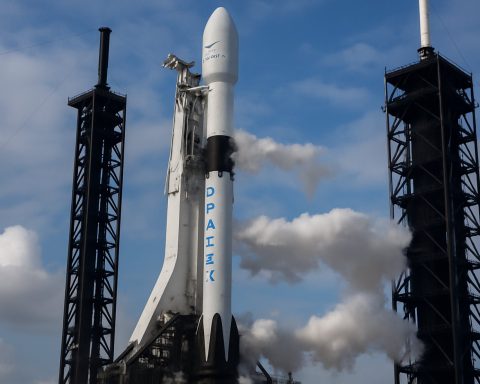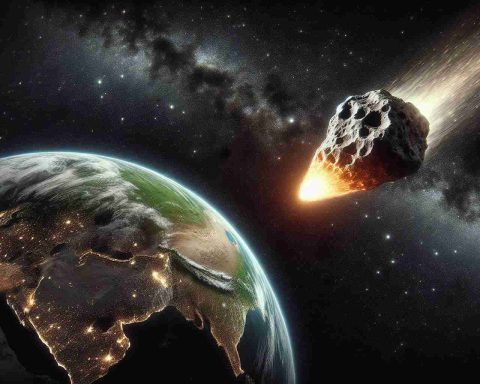- Asteroid 2024 YR4, previously considered a significant threat, no longer poses any danger to Earth.
- Originally discovered in December 2024, 2024 YR4 had a worrying 1-in-32 chance of impacting Earth, rated Level Three on the Torino scale.
- Diligent observation and data analysis by astronomers successfully altered its trajectory, reducing the risk to Level Zero.
- Astronomers, like David Rankin, highlight the importance of precise science in navigating the unpredictable behavior of asteroid paths.
- The incident underscores humanity’s growing capability in cosmic monitoring and the use of science to mitigate potential space threats.
A cosmic bullet has been dodged. Asteroid 2024 YR4, once a looming presence in the realm of near-Earth objects, no longer poses a threat to our planet. This space wanderer, initially flagged as a high-risk entity, has been nudged off its alarming trajectory by the sharp eyes of astronomers and the diligent work of data analysts.
Imagine this: a celestial rock, flirting with the fragile balance of our solar system, suddenly veers off course. In December 2024, when discovered, 2024 YR4 had scientists gripping their telescopes for signs of a threatening impact. At its peak, the asteroid’s odds of hitting Earth were worrisomely high, boasting a 1-in-32 chance and settling into Level Three on the Torino scale of impact risks.
But like a suspenseful storyline unfolded under the fearless observation of human playmakers, the asteroid’s heavily scrutinized path began to change. Each new data point, each fresh image, chiselled away the odds of catastrophe, until finally, the risk evaporated into the void of space. Now resting harmlessly at Level Zero, 2024 YR4 is a testament to the power of precise science and vigilant observation.
Astronomer David Rankin likens the wild dance of asteroid paths to adjusting a stick from many miles away: a minor shift here, a profound change there. This inherent variability underscores a comforting truth in the daunting realm of space. Science and persistence reveal the cosmos not as an unpredictable adversary, but as a classroom where every observation is a reassuring lesson.
While 2024 YR4 fades from the spotlight, it reminds us of our growing prowess in cosmic vigilance. It tells a story of assurance—our capacity to unravel the mysteries of space orbits, smoothing the cosmic wrinkles to keep future threats at bay. As we fortify our understanding, we can rest a little easier under the vast, watchful sky.
How We Dodged the Asteroid: What You Need to Know About Near-Earth Objects
How-To Steps & Life Hacks: Tracking and Mitigating Asteroid Risks
1. Early Detection: Utilizing powerful telescopes and space observatories, scientists can identify potential near-Earth objects (NEOs). Instruments like the Pan-STARRS and the Catalina Sky Survey play vital roles.
2. Data Analysis: Once detected, astronomers analyze the orbit using complex algorithms and observational data. This involves calculating the object’s trajectory, speed, and potential for collision with Earth.
3. Continuous Monitoring: As new data is collected, predictions are updated continually. This dynamic assessment reduces false alarms and unnecessary panic.
4. Deflection Strategies: If a threat level is high, agencies may consider deflection tactics, including kinetic impactors or gravitational tractors to alter the object’s path.
5. Public Communication: Timely communication from agencies such as NASA and ESA is critical for public awareness and safety.
Real-World Use Cases
Asteroid tracking has significant real-world applications:
– Risk Assessment: Provides data for potential disaster management plans.
– Space Mining: Understanding asteroids could open new frontiers in mining rare minerals from these celestial bodies.
– Planetary Defense: Informs strategic planning for potential defense missions by global space agencies.
Market Forecasts & Industry Trends
With advancements in space technology, the market for asteroid tracking and mitigation systems is poised for growth.
– Investment in Space Observatories: Significant funding is being channeled into space observatories like the James Webb Space Telescope.
– Commercial Interest: Private companies such as SpaceX and Blue Origin are exploring asteroid mining potential, which could lead to new economic opportunities.
Reviews & Comparisons
– NASA’s Planetary Defense Coordination Office vs. ESA’s Space Situational Awareness Programme: Both are at the forefront but differ in scope, with NASA focusing on a broader detection and deflection strategy, while ESA is more observational.
Controversies & Limitations
– Predicting asteroid paths remains a complex task due to gravitational influences and Yarkovsky effect (small force exerted due to thermal emissions).
– Limited resources and the vastness of space leave small, yet potentially hazardous objects undiscovered.
Features, Specs & Pricing
– Space Telescopes: Instruments like the Hubble and the upcoming NEO Surveyor are critical but come with hefty price tags reaching into billions of dollars.
Security & Sustainability
– International Collaboration: Effective global collaboration is key to sustainable space safety practices.
– Sustainability Initiatives: Efforts are ongoing to minimize space debris, which can complicate tracking activities.
Insights & Predictions
– Experts predict that continuous advancements in technology will significantly reduce future impact risk levels. With increasing investment, humanity’s ability to monitor and mitigate celestial threats will grow exponentially.
Pros & Cons Overview
Pros:
– Enhanced planetary defense.
– Technological advancements.
– Economic potential in asteroid mining.
Cons:
– High cost of space missions.
– Risk of incomplete data leading to inaccurate predictions.
Actionable Recommendations
– Stay informed through credible sources like NASA and ESA.
– Encourage educational initiatives that generate interest in STEM fields, bolstering future planetary defense efforts.
– Support funding for space research to enhance detection technologies.
By understanding these aspects, we can better appreciate the efforts in keeping Earth safe from cosmic hazards and encourage future innovations in space exploration.











